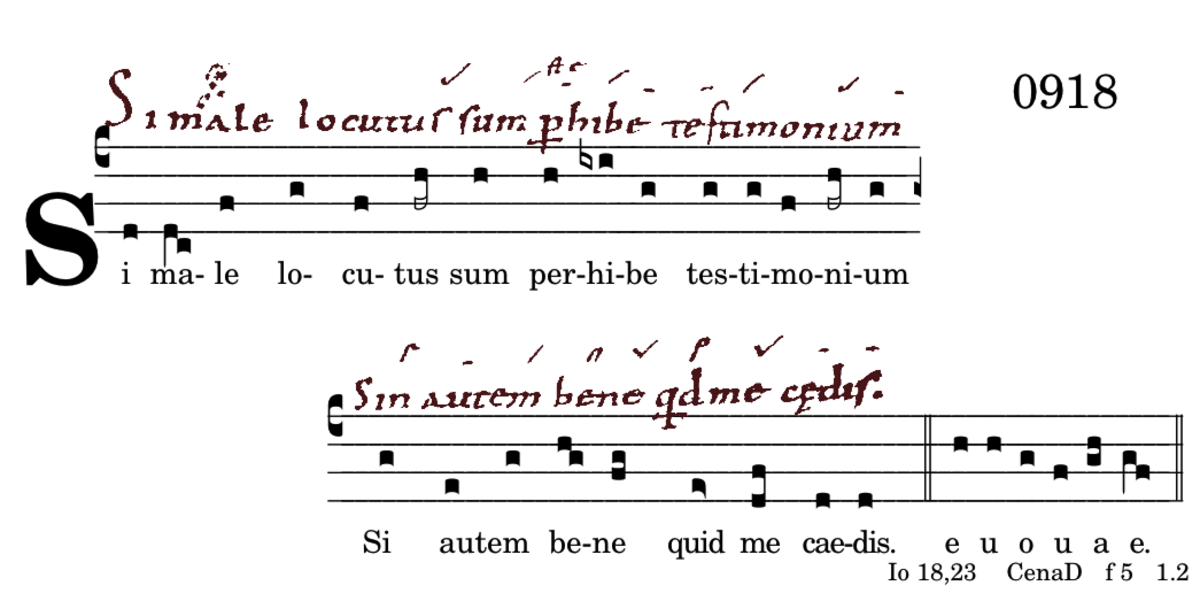🔘 IN GR TR AL OF CO xxxxx ✅ 2️⃣ 0️⃣ 3️⃣ 4️⃣ 5️⃣ 6️⃣ 7️⃣ 8️⃣ xxxxx AN RP IV alia
0918 AN Si male locutus sumModus 1
Ein klarer TYPOS, der in allen Handschriften außer Benevent + Hartker die MED in eine FML supra überleitet.
 1INC Clv mit PPO.
1INC Clv mit PPO.
1MED typ PPO „pér-hibe testimonium.“ Hier ist Jesu Erwiderung zu Ende. Hartker geht vorsichtiger zu Werke: MED schließt nicht ab (*), läßt offen. Allerdings wird MED anders unterlegt „per-hí-be und mit einer kleinen Varianteversehen: der Ton „perhi-be“ wird um eine Sekunde tiefer gesetzt, unisonisch mit dem nächsten. Das verhindert den Fluss, staut und macht die Aussage nachdrücklicher: „perhíbe) testimonium“ - „beweise, dass es Unrecht ist“.
1NOV typ Virga strata kündigt neuen Cento an. Der nkPes am Ende hat weiterführende Funktion colon, macht die TER penultimo accento zur zweiten Hauptaussage.
1TER penult In diesem Fall ist der QuartPes zur Terz reduziert (Cephalicus, TerzPes, steile Fügung „mé cáe-dis“). Der QuartPes wäre, von Jesus über sich selbst gesagt, peinlich. Ebenso wäre die Melodie kaum singbar ohne Silbe zwischen QuartPes re-sol und Finalis re. Diese doppelte Reduktion nimmt Lautstärke zurück, ohne die Frage abzuschwächen.

● Habe ich übel geredet, so beweise es.
Hab ich aber recht geredet, warum schlägst du mich?.
● If I have spoken evil, prove it.
But if I have spoken rightly, why do you strike me?
A clear TYPOS, which in all manuscripts except Benevent + Hartker leads the MED into an FML supra.
 1INC Clv with PPO.
1INC Clv with PPO.
1MED typ PPO “pér-hibe testimonium.„ This is the end of Jesus' reply. Hartker is more cautious: MED does not conclude (*), leaves it open. However, MED is underlaid differently „per-hí-be and provided with a small variation: the note „perhi-be“ is placed a second lower, in unison with the next. This prevents the flow, congests and makes the statement more emphatic: „perhíbe) testimonium“ - „prove that it is wrong“.
1NOV typ Virga strata announces new cento. The nkPes at the end has a further function colon, makes the TER penultimo accento the second main statement.
1TER penult In this case, the QuartPes is reduced to a third (Cephalicus, TerzPes, steep inflection „mé cáe-dis“). The fourthPes would be embarrassing, said by Jesus about himself. Similarly, the melody would hardly be singable without a syllable between the fourthPes re-sol and finalis re. This double reduction reduces volume without weakening the question.


